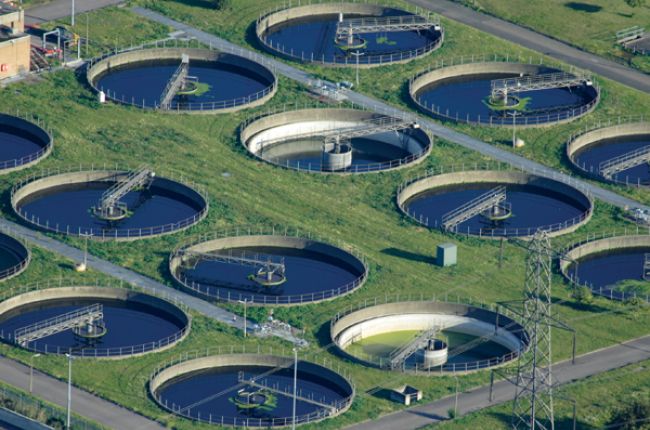Cost-Effective Solutions for Large-Scale Waste Water Treatment Facilities
Cost-Effective Solutions for Large-Scale Waste Water Treatment Facilities
Blog Article
Discovering Ingenious Technologies and Practices for Reliable Drainage Treatment Solutions
Effective waste water treatment systems are vital for environmental sustainability and public health. From advanced filtration approaches to wise tracking systems and biological therapy technologies, the area of waste water treatment is seeing a makeover.
Advanced Purification Approaches

Microfiltration involves making use of great membranes to different fragments and bacteria, while ultrafiltration targets even smaller sized contaminants via finer pores. Nanofiltration works on eliminating divalent ions and natural molecules, and reverse osmosis is extremely reliable in eliminating liquified salts and other toxins. Waste Water Treatment. These approaches not only aid in generating tidy water but additionally aid in minimizing the ecological impact of wastewater discharges, making them crucial components of modern wastewater therapy systems

Smart Keeping An Eye On Equipments
The implementation of smart tracking systems revolutionizes the oversight and management of wastewater treatment processes, making sure optimum efficiency and compliance with regulative criteria. These systems make use of innovative sensing units, information analytics, and real-time surveillance to provide valuable insights into various parameters of the treatment process. By continuously accumulating and evaluating data on essential signs such as pH levels, turbidity, dissolved oxygen, and flow rates, smart surveillance systems make it possible for drivers to immediately identify any deviations from the desired operating problems. This aggressive technique enables quick interventions to address concerns prior to they intensify, ultimately boosting the general effectiveness and efficiency of the therapy plant. Furthermore, clever monitoring systems help with remote surveillance and control, making it possible for operators to gain access to real-time data and make notified choices from anywhere, at any time. This degree of connection and automation not only enhances functional performance yet also minimizes the danger of non-compliance with environmental policies, causing set you back financial savings and environmental management.
Biological Therapy Advancements
Biological therapy technologies have significantly progressed the effectiveness and sustainability of wastewater therapy processes. In general, organic treatment developments supply affordable, ecologically pleasant services for wastewater therapy, advertising sustainable techniques in water resource management. Executing these modern technologies can lead to enhanced water quality, minimized ecological impact, and improved source recovery in wastewater therapy systems.
Energy-Efficient Practices
In advancing the sustainability of wastewater treatment systems, energy-efficient practices play a critical duty in optimizing operational expenses and reducing environmental influence. One key energy-efficient method is the execution of advanced oygenation systems, such as great bubble diffusers or surface aerators, which improve oxygen transfer performance in organic treatment processes. By enhancing oygenation efficiency, treatment plants can decrease power intake connected with aeration, a considerable factor to total energy use in wastewater therapy.
Furthermore, the integration of renewable resource resources, like photovoltaic panels or wind generators, can aid counter power demands and decrease dependence on typical nonrenewable fuel sources. Making use of energy recovery systems, such as heat exchangers or biogas catch technologies, can additionally add to power cost savings by repurposing waste warm and recording biogas produced during treatment processes.
Additionally, utilizing energy administration systems and advanced control techniques can enhance energy usage by changing operational criteria in real-time based on differing treatment conditions. In general, incorporating energy-efficient practices not just lowers functional expenses yet additionally minimizes the environmental footprint of wastewater treatment centers, aligning with sustainable advancement goals and regulative demands.
Data-Driven Optimization
How can data-driven optimization boost the performance and efficiency of wastewater treatment systems? Data-driven optimization plays an essential duty in enhancing the performance of wastewater therapy systems by enabling real-time tracking, predictive upkeep, and informed decision-making - Waste Water Treatment. By accumulating and examining data from numerous sensors and sources within the therapy plant, operators can obtain useful insights into the system's operation, determine prospective issues prior to they escalate, and maximize processes to attain better end results
With data-driven optimization, drivers can carry out predictive maintenance strategies that aid stop equipment failings and minimize downtime. By evaluating historic data and patterns, upkeep schedules can be enhanced, leading to cost savings and raised system dependability. In addition, real-time data tracking permits immediate discovery of anomalies or discrepancies from optimum operating problems, allowing punctual corrective actions to be taken.
In addition, data-driven optimization helps with data-driven decision-making by supplying operators with actionable insights and suggestions based upon information analysis - Waste Water Treatment. This enables for constant renovation and optimization of wastewater treatment processes, causing boosted performance, lowered operational costs, and boosted overall performance click for source of the system
Final Thought
In verdict, the expedition of cutting-edge technologies and methods for effective drainage therapy systems has actually shown encouraging results in improving filtering techniques, keeping an eye on systems, organic therapies, energy performance, and data optimization. These innovations are essential in dealing with the growing challenges of water scarcity and pollution. By applying these remedies, we can guarantee effective and lasting monitoring of wastewater sources for the benefit of both the environment and culture.
From sophisticated filtering techniques to smart surveillance systems and organic treatment innovations, hop over to here the area of waste water treatment is experiencing a change.Biological therapy advancements have significantly progressed the efficacy and sustainability of wastewater therapy procedures. In general, organic treatment innovations supply economical, environmentally friendly services for wastewater therapy, promoting lasting methods in water resource administration. By improving oygenation efficiency, treatment plants can lower energy intake connected with oygenation, a considerable contributor to general energy usage in wastewater therapy.
In final thought, the expedition of ingenious modern technologies and methods for efficient waste water treatment systems has actually shown encouraging results in boosting filtering approaches, monitoring systems, hop over to these guys organic treatments, energy performance, and data optimization.
Report this page